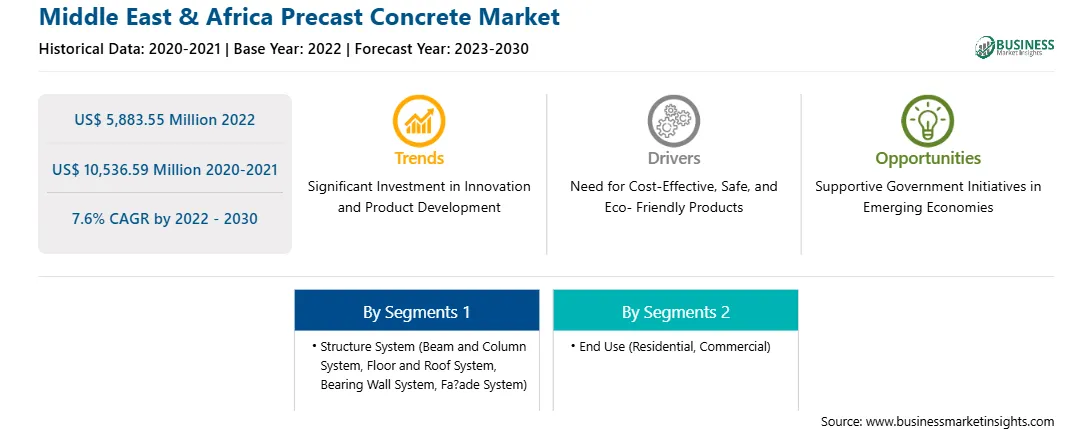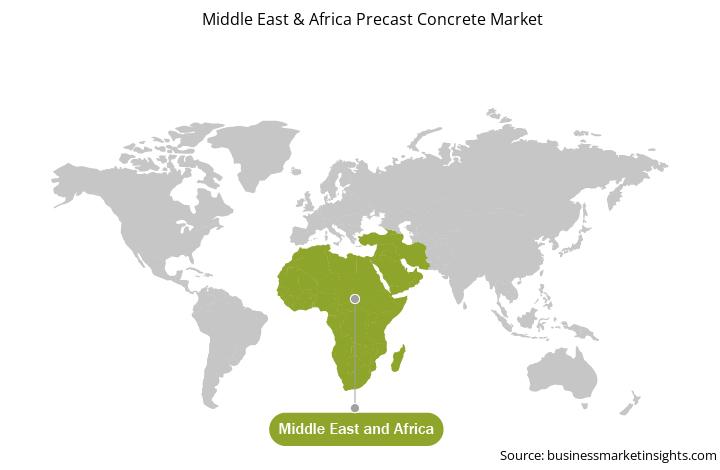The Middle East & Africa precast concrete market was valued at US$ 5,883.55 million in 2022 and is expected to reach US$ 10,536.59 million by 2030; it is estimated to register at a CAGR of 7.6% from 2022 to 2030.
Precast technology is often correlated with performance, protection, and durability, all of which are good advantages over traditional building methods. However, one of the essential advantages of precast is its potential to reduce construction costs and provide substantial savings before, during, and after the project. Moreover, unlike other materials used in conventional building components, precast components are usually made of locally available natural raw materials such as cement, stones, sand, and gravel, and they can be reused or recycled completely, which helps to reduce the environmental impact of raw materials over their life cycle. In addition to this, focus have been made to promote safe and digitized construction which could lessen the number of fatalities at the site. For instance, several reported incidents suggest the fatalities caused while lifting hollow-core slabs with clamps. Hence, the use of precast components in the construction work can has ensure the safety and protection at construction sites.
Precast concrete is also a popular building material for office buildings. The building's walls can be fabricated while the on-site foundations are being built, thereby saving time, and ensuring early occupancy. Due to the speed and ease with which precast structures can be constructed, precast has become a popular building material for parking structures. Precast concrete allows for safe, cost-effective construction in all weather conditions.
It also provides long clear spans and open spaces needed in parking structures. In addition, precast concrete saves time and money, and it has greater quality control than on-site concrete construction. Precast concrete construction has many benefits such as ecofriendly, earthquake resistance, energy- efficient, and others than cast-in-situ concrete structures, as well as steel, timber, and masonry structures. It allows for a faster and more reliable construction process. The rising focus toward cost-effective, safe, and environment-friendly products is expected to stimulate the growth of the Middle East & Africa precast concrete market.
The Middle East and Africa region include countries such as South Africa, Saudi Arabia, UAE, and the Rest of the Middle East and Africa. The Middle East and Africa market is experiencing rapid development with the growth of markets such as Dubai, Abu Dhabi, and Iran. New investment and better marketing strategies have led to the capture of market share in the Middle East and African region. The shift in consumer lifestyles, coupled with industrialization and urbanization, enhances construction activities, which is eventually expected to stimulate the precast concrete market. Precast concrete is witnessing rapid development in the Middle East due to the increased adoption of the advanced precast concrete by the region's end-use industries. The precast concrete market is highly driven by economic development, along with the growing end-use industries.
The Gulf countries are economically developed countries, whereas the African countries are yet to match up to the economic conditions of the Gulf countries and lag far behind. The harsh weather conditions of the desert, lack of unskilled laborers, and high labor wages in the region act as huge hindrances in the development of the region. However, urbanization in the Middle Eastern is transforming the outlook of countries. Middle Eastern countries look ahead for the adoption of advanced technologies and also stand amongst the most highly urbanized region. Responding towards a shift occurring in global economic power has positioned the Middle East firmly as a world's fastest-growing market, including Dubai and Abu Dhabi, with an aim to turn into global hubs. Therefore, the rising urban population has improved the construction of private residential buildings from semi-urban and urban cities. Concrete is one of the most used construction materials worldwide, especially in the Middle East & Africa. It is considered a cheap composite due to the low cost of raw material. Besides, it is a strong material in durable, compression, resistant, and versatile. One of the most common applications in concrete construction is precast concrete which is primarily used for walls, floors, and structural elements. Once completed, these components are delivered to construction site, then assembled by cranes to form a building. There are numerous reasons why architectural precast has gained popularity in the region. Precast concrete offers long term durability and require minor maintenance. These factors further boost demand for precast concrete in the Middle East region.
Furthermore, supported by the government, Dubai has developed industrial hubs in this region. The key motive of the industrial hub is to attract manufacturers looking to set up new plants. According to the UAE's Department of Economic Development (DED), the manufacturing industry accounts for 80 percent of Dubai's non-oil trade, which makes it the second-largest contributor to the UAE economy. The government is looking forward to investing large amounts in the building and construction industry. Moreover, the presence of leading manufacturers in the region such as Gulf Precast, CEMEX S.A.B. de C.V., and others is further anticipated to lead to the growth of precast concrete in the region.

Strategic insights for the Middle East & Africa Precast Concrete provides data-driven analysis of the industry landscape, including current trends, key players, and regional nuances. These insights offer actionable recommendations, enabling readers to differentiate themselves from competitors by identifying untapped segments or developing unique value propositions. Leveraging data analytics, these insights help industry players anticipate the market shifts, whether investors, manufacturers, or other stakeholders. A future-oriented perspective is essential, helping stakeholders anticipate market shifts and position themselves for long-term success in this dynamic region. Ultimately, effective strategic insights empower readers to make informed decisions that drive profitability and achieve their business objectives within the market.

| Report Attribute | Details |
|---|---|
| Market size in 2022 | US$ 5,883.55 Million |
| Market Size by 2030 | US$ 10,536.59 Million |
| Global CAGR (2022 - 2030) | 7.6% |
| Historical Data | 2020-2021 |
| Forecast period | 2023-2030 |
| Segments Covered |
By Structure System
|
| Regions and Countries Covered | Middle East and Africa
|
| Market leaders and key company profiles |
The geographic scope of the Middle East & Africa Precast Concrete refers to the specific areas in which a business operates and competes. Understanding local distinctions, such as diverse consumer preferences (e.g., demand for specific plug types or battery backup durations), varying economic conditions, and regulatory environments, is crucial for tailoring strategies to specific markets. Businesses can expand their reach by identifying underserved areas or adapting their offerings to meet local demands. A clear market focus allows for more effective resource allocation, targeted marketing campaigns, and better positioning against local competitors, ultimately driving growth in those targeted areas.

The Middle East & Africa precast concrete market is segmented based on structure system, end use, and country.
Based on structure system, the Middle East & Africa precast concrete market is segmented into beam and column system, floor and roof system, bearing wall system, façade system, and others. The beam and column system segment held the largest share in 2022.
In terms of end use, the Middle East & Africa precast concrete market is segmented into residential, commercial, and others. The residential segment held the largest share in 2022.
Based on country, the Middle East & Africa precast concrete market is categorized into South Africa, Saudi Arabia, the UAE, and the Rest of Middle East & Africa. The Rest of Middle East & Africa dominated the Middle East & Africa precast concrete market in 2022.
Heidelberg Materials AG, Cemex SAB de CV manufacturer, Holcim Ltd, Consolis Group SAS, and Laing O'Rourke Plc are some of the leading companies operating in the Middle East & Africa precast concrete market.
1. Heidelberg Materials AG
2. Cemex SAB de CV manufacturer
3. Holcim Ltd
4. Consolis Group SAS
5. Laing O'Rourke Plc
The Middle East & Africa Precast Concrete Market is valued at US$ 5,883.55 Million in 2022, it is projected to reach US$ 10,536.59 Million by 2030.
As per our report Middle East & Africa Precast Concrete Market, the market size is valued at US$ 5,883.55 Million in 2022, projecting it to reach US$ 10,536.59 Million by 2030. This translates to a CAGR of approximately 7.6% during the forecast period.
The Middle East & Africa Precast Concrete Market report typically cover these key segments-
The historic period, base year, and forecast period can vary slightly depending on the specific market research report. However, for the Middle East & Africa Precast Concrete Market report:
The Middle East & Africa Precast Concrete Market is populated by several key players, each contributing to its growth and innovation. Some of the major players include:
The Middle East & Africa Precast Concrete Market report is valuable for diverse stakeholders, including:
Essentially, anyone involved in or considering involvement in the Middle East & Africa Precast Concrete Market value chain can benefit from the information contained in a comprehensive market report.